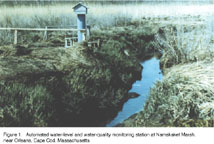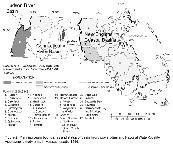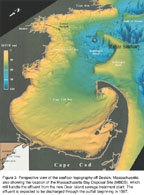|
|
The U.S. Geological Survey (USGS), which was established by Congress in the
Organic Act on March 3, 1879, provides geologic, topographic, hydrologic,
and biologic information to the Nation. This information comprises maps,
data bases, and reports that contain analyses and interpretations of water;
energy, mineral, and biologic resources; land surface; geologic structures;
natural hazards; and the dynamic processes of the
Earth. |

|
|
|
|
Since 1988, the USGS, in cooperation with the Massachusetts Department of
Environmental Protection (MDEP) and the Cape Cod Commission, has been
tracking the movement of ground water that contains high concentrations of
nitrogen from a sewage-treatment facility toward Namskaket Marsh, which is
a major salt marsh on Cape Cod (fig. 1). The Namskaket Marsh project will
directly benefit the State and regional authorities responsible for the
siting and approval of new sewage-treatment facilities in the rapidly
developing coastal zone of Massachusetts. Nutrient loading from point and
nonpoint sources is a major concern in the coastal zone because such
nutrients can ultimately enter coastal waters and cause algal blooms,
depletion of dissolved oxygen, fish kills, and general habitat degradation.
In baseline studies of the hydrology and chemistry of Namskaket Marsh, the
USGS has quantified the distribution and rates of ground-water discharge.
Namskaket Creek sediments have been shown to be particularly active zones
of ground-water discharge and nitrogen uptake. Moreover, the uptake
capacity of these sediments is not fully utilized at present and could
increase in response to increased nitrogen loading associated with the
adjacent sewage-treatment facility. The USGS, in collaboration with the
Woods Hole Oceanographic Institution, also has mapped the natural
vegetation communities in the marsh and conducted long-term fertilization
experiments to evaluate the likely response of these communities to
increased nutrient loading from ground water. Because a large fraction of
the Massachusetts coastline is occupied by salt marshes, the results of the
project will have broad significance for wastewater management throughout
Massachusetts. |

(Larger Version, 130K JPEG)
|
|
Figure 1. Automated water-level and water-quality monitoring station at
Namskaket Marsh, near Orleans, Cape Cod, Massachusetts.
| |

|
|
|
|
Contamination from landfills, sewage-treatment facilities, and other land
uses can seriously affect the quality of ground-water resources.
Understanding processes that affect the fate of contaminants in ground
water is critical for the protection of ground-water resources and the
remediation of ground-water contamination. |
As part of its Toxic Substances Hydrology Program, the USGS is studying the
movement of contaminated ground water that emanates from the Massachusetts
Military Reservation (MMR), on Cape Cod, and the complex interaction of
hydrologic, chemical, and microbial processes that occur in the
contaminated aquifer that underlies the site. Computer models of
ground-water flow developed by the USGS for the MMR area were useful to the
National Guard Bureau in planning a program to halt the advance of
contaminated ground water in seven other areas on the MMR. |

|
|
|
|
The Massachusetts Department of Environmental Management (MDEM) is
developing plans to manage water in 27 river-basin planning units in the
State. The USGS, in cooperation with the MDEM, is investigating eight of
the planning units and is providing information that is useful to the MDEM
in developing these management plans. Reports that summarize the results
of investigations such as availability and quality of surface and ground
water, interactions between surface and ground water, and transport of
sediment by rivers, are prepared as the data become available. |
The USGS and the MDEM also are cooperating in two other investigations.
Results of one of these will provide data to develop low-flow statistics
for Massachusetts streams. The other investigation is obtaining
information on the withdrawal, distribution, use, and return of water by
municipal, agricultural, commercial, and industrial water users.
Information from the USGSÐMDEM investigations helps water-resource planners
locate potential new water-supply sources, plan and manage for droughts,
design wastewater-treatment and other facilities, and assess water
withdrawals and interbasin water transfers. |

|
|
|
Pollution affects many of the Nation's streams and aquifers. In 1991, the
USGS began its National Water-Quality Assessment (NAWQA) Program to
describe the quality of many of the Nation's streams and aquifers. Results
from one of the regional NAWQA projects, the Connecticut, Housatonic, and
Thames Rivers study, include the following:
- Pesticides were commonly found in streams that drain urban areas and large
tracts of agricultural land, but concentrations rarely exceeded the
detection levels in streams that drain undeveloped areas.
- Twenty-five volatile organic compounds, generally petroleum compounds and
solvents, were detected in water from shallow wells that tap glacial sand
and gravel aquifers beneath urban areas. The gasoline additive methyl
tert-butyl ether (MTBE) was detected in 35 percent of the water samples
collected from shallow, urban wells. All MTBE detections were less than
3.0 micrograms per liter.
|
- Riverbed-sediment samples indicated that seven U.S. Environmental
Protection Agency (USEPA) Priority Pollutants, which included antimony,
cadmium, copper, lead, mercury, silver, zinc, and sulfur, were at
above-natural levels in areas of intensive urban land use, large
population densities, and large numbers of point-source discharges
upstream of the collection point.
- PCB's and DDE (a DDT metabolite) were found in fish tissues sampled
throughout the study area, with 28 detections of PCB and 31 detections of
DDE at 32 sites. PCB's were found to have the highest levels,
particularly on the Housatonic River, where concentrations were more than
10 parts per million at the three sites sampled there.
- A new type of geologic map was developed in which geologic formations are
recast into lithochemical units. This map helps in the interpretation of
natural water-quality variations owing to the influence of the rock and
sediment geochemistry.
|

|
|
|
|
Quabbin Reservoir (fig. 2) provides high-quality drinking water to more
than 2.5 million people in 44 communities in central and eastern
Massachusetts. About 65 percent of the 96,000-acre Quabbin Reservoir
drainage basin is managed by the Metropolitan District Commission (MDC) and
preserved as State-owned forest land. The MDC is responsible for
protecting the quantity and quality of water that discharges from the
drainage basin to the reservoir.
The USGS and the MDC are cooperating to classify small watersheds by land
use, topography, geology, soils, and streamwater quality. If similarities
among watershed groups can be identified, then hydrologic and water-quality
management models can be developed that will apply to watersheds with
similar characteristics. Data collected by the USGS, the MDC, the
University of Massachusetts, and the MDEP will be used to refine watershed
classification. |

(Larger Version, 98K GIF)
|
|
Figure 2. Planning basin boundaries and status of basin hydrology studies
and National Water-Quality Assessment study units in Massachusetts, 1996.
| |

|



